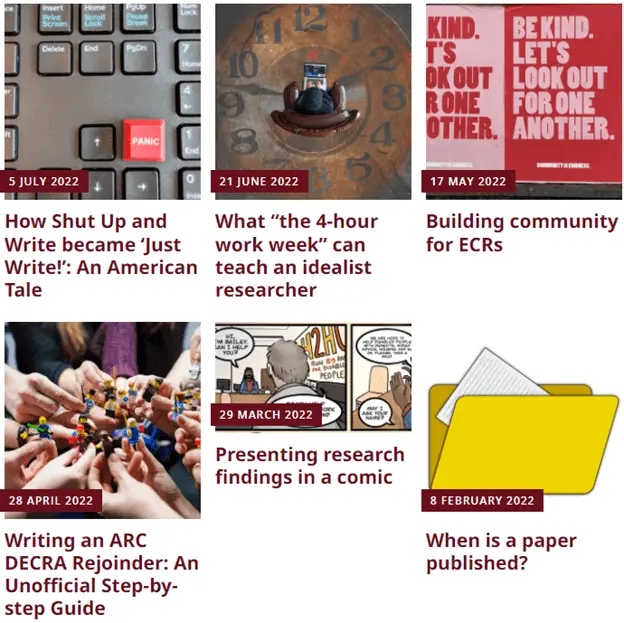Education
15 Must-Read Academic Blogs for Researchers and Ph.D. Students

When searching the internet for information on a variety of subjects, blogs have rapidly become one of the most common resources. There is a wide variety of content available to read online, ranging from specialized content written by professionals to hobbyist content such as mom blogs and cuisine blogs. The question is, how do you choose which blogs to read when you’re going to write a research paper and seek scholarly and educational information for your research rather than just browsing for ‘write my papers for me’ services?
It is easy to get overwhelmed and lost when searching for academic blogs to read, especially when you are a doctoral student or a researcher. To help make the process easier, here is a list of some must-read academic blogs that will keep you updated on current research, new discoveries, and emerging topics.
1. DoctoralWritingSIG
DoctoralWritingSIG is a useful forum for anyone interested in doctorate writing to “exchange knowledge, resources, ideas, and dreams,” regardless of where they are in their academic careers. The blog covers subjects such as grant writing, instructions on writing the various components of a thesis or dissertation, grammatical advice, and academic publishing advice in order to establish a foundation of knowledge and abilities surrounding research writing.
2. Academics Write
Academics Write is a blog run by academics for academics. It engages post-secondary teachers, academic writing specialists, and students to evaluate the significance of writing, self-efficacy, academic writing misunderstandings, and instances in which students can be granted an extension for their projects. The posts are short and concise, making them easy to read at work or on a study break. Thanks to the variety of topics covered and the range of academics writing the posts, this blog can be a valuable resource for doctoral students conducting research, as well as instructors and teachers.
3. The Research Whisperer


The Research Whisperer is dedicated to the topic of doing research in academia. The blog aims to let readers know “what it’s like to do a Ph.D. at the moment when so many voices are shouting that we’re doing it wrong.” The blog features personal stories from researchers and Ph.D. students, as well as reviews of books and films relevant to the research community.
4. The Professor is In
From book summaries to book reviews and recommendations, this blog is a great source for finding the best books to read on a variety of academic topics. This blog is a source of academic advice for students everywhere. From general advice to topics such as grammar and writing, this blog will help any researcher improve their studies.
5. Eva Lantsoght
Dr. Eva Lantsoght, Researcher at Delft University of Technology, manages the blog PhD Talk. PhD Talk publishes blog postings about the “process of doing a Ph.D., the non-scientific skills you need during your PhD,” as well as Dr. Lantsoght’s experiences living and traveling abroad. She also blogs on structural concrete, which is her current research topic. Her blog entries contain research and academic writing techniques, as well as other themes including presenting at academic conferences, life as a Ph.D., being productive, and efficiently managing time. Dr. Lantsoght also welcomes submissions from guest contributors, with a special invitation to individuals who want to try their hand at academic blogging before launching their own website.
6. Write, Publish, Thrive
Write, Publish, Thrive is a writing, publishing, and intellectual life blog. Dr. Rich Furman, a professor at the University of Washington, manages it. Dr. Furman’s goal is to assist academics in “maximizing their skills and transcending their psychosocial hurdles in order to construct successful careers and prosper.” In light of this, among other resources, Write, Publish, Thrive provides practical strategies for publishing scientific publications and strengths-based counseling for academics.
7. The Skeptical Scientist (Timvanderzee)


Tim van der Zee, a Ph.D. student at Leiden University, manages the blog The Skeptical Scientist. Tim explains the name of his blog: skeptical scientists are individuals who are skeptical about their own research, what they read, and strive to increase evidential value. He discusses research methods, study design, evidence, (statistical) inference, and how we might better science in this site. The Skeptical Scientist discusses issues including how to apply for a position in academia and how to assess confidence intervals.
8. Athene Donald’s Blog
Athene Donald has been a professor of physics at the University of Cambridge for almost 20 years. Unlike some of the other blogs on this list that take a coaching-oriented approach, Professor Donald’s blog appears to present the ideas and viewpoints of researchers. Her blog entries address issues such as what to do and what not to do during academic conferences, gender disparities in academia, and so on. She also tries to strike a balance by posting a few blog entries about her own life and interests.
9. Dan Cohen
Dr. Dan Cohen is a Vice Provost, Dean, and Professor at Northeastern University and writes articles on current trends in the IT industry, digital libraries, eBooks writing, web cultures, digital humanities, communication trends, science of publishing, and the impact of digital media in our daily life.
10. Happy Academic
The topics range from posts about mental health in academia, lessons learned from teaching, teaching tips, and scholarly articles to helpful study tips, career advice, and work-life balance hints.
11. The Thesis Whisperer
This blog is committed to helping Ph.D. students to complete their thesis. This blog has useful material, therefore if you are working on a thesis, this could be the site for you.
12. Ph.D. Life
While this blog is British, there are loads of advice, tricks, insights, and some humor about the Ph.D. process, postdoctoral work, and life in academia. The author presents articles that are helpful for those starting their doctoral journey, as well as those in the middle of it.
13. Studybay
The blog covers topics such as the application of blockchain technology in the writing field, the common grammar mistakes that students make when they write, and the most effective writing styles.
14. From PhD to Life
Dr. Jennifer Polk, a history PhD turned academic, life, and career coach for graduate students and PhDs, runs the blog From PhD to Life. Dr. Polk summarizes her work by stating that she assists “PhDs in launching meaningful careers” by assisting them in delving further into their own interests, exploring their possibilities, and dealing with academic pressure. From PhD to Life provides a wide range of tools for PhDs, all of which are targeted at assisting them in navigating their academic careers and living a better life. Dr. Polk considers her Transition Q&A series to be a must-read! This section features inspiring stories from PhDs about their rewarding post-PhD journeys.
15. Inside Higher Ed
Inside Higher Ed is a website that compiles blogs on a variety of scholarly issues and presents them in blog format. There is something for everyone here, from adaptability in educational settings to growth opportunities in the military. In addition to that, it consists of online technologies and digital learning resources that can aid support remote and online learning.
As a researcher or Ph.D. student, you always want to be on the cutting edge of your field. To do that, you need to be reading the latest and greatest academic research. But with so many blogs out there, it can be tough to know which ones are worth your time. Luckily, we’ve compiled a list of the best academic blogs that you should be reading. From blogs about the latest research findings to ones that offer advice on writing and publishing, these blogs have something for everyone. So, take a look and start reading!
There are many thousands of academic blogs out there, so we haven’t been able to try them all nor can we vouch for the accuracy of every post on these blogs. The caliber of writing and the accuracy of any given blog can vary over time so please do not consider this list an absolute ranking of these blogs.


Education
Revealing Your Musical Potential: How Structured Music Lessons Can Aid Novices


Discovering one’s musical capabilities begins with the first note, chord, or beat.
Music lessons for beginners is the journey into the realm of music, which can be both exhilarating and daunting. The secret to unveiling this potential resides in practice and structured lessons to build a strong foundation.
This article delves into how these lessons serve as a cornerstone for novices, enabling them to explore, understand, and refine their skills.
The Importance of a Solid Start
Embarking on this education requires more than just enthusiasm. A solid start, anchored in comprehensive music lessons for beginners, sets the tone for a learner’s journey. It ensures that fundamental concepts are not just introduced but understood and internalised.
This approach minimises confusion and builds a platform from which skills can be developed systematically.
Tailored Approach to Learning
Every individual possesses unique learning capabilities and musical inclinations. Structured lessons cater to these differences, offering tailored approaches that match the learner’s pace and interest.
This personalisation enhances engagement and ensures that each session contributes effectively to their progress. By addressing the learner directly, lessons become more than instruction; they become a dialogue between the student and the music.
Building Blocks of Musical Knowledge
At the core of music lessons for beginners lie fundamental concepts that are indispensable for all subsequent learning and mastery. These foundational elements encompass the comprehension of musical notation, the essence of rhythm, the scales’ structure, and the chords’ formation.
A firm grasp of these basics is pivotal for progressing to intricate compositions and diverse genres.
Furthermore, lessons meticulously crafted to systematically introduce and reinforce these concepts significantly contribute to cultivating a rich lexicon. They enable learners to interpret music more quickly and express themselves fluently through their chosen instrument.
This systematic approach ensures a well-rounded understanding, laying a solid groundwork for exploration and creativity in the journey.
The Role of Feedback and Correction
Structured lessons provide a platform for consistent and constructive feedback, allowing beginners to recognise their strengths and areas for improvement. This corrective mechanism is vital in avoiding the entrenchment of incorrect techniques, which can hinder progress.
The Joy of Early Achievements
Structured lessons aim to impart knowledge and recognise and celebrate every milestone achieved along the way, no matter how modest. Mastering a basic melody or composing a first piece are significant markers of progress, essential for boosting motivation.
These accomplishments are potent reminders to beginners of their strides, underscoring the tangible outcomes of their perseverance and hard work. Celebrating these successes is vital to maintaining enthusiasm and fostering a deep commitment to this art form. It instils confidence in learners, encouraging them to set and achieve new goals.
Beyond the Basics: Encouraging Exploration
Once beginners have a solid grasp of the fundamentals, these lessons evolve to encourage a journey beyond foundational skills. This new exploration phase invites learners to delve into various genres, fostering an appreciation for diversity.
Experimentation becomes key through composing original works, improvising within known pieces, or collaborating with fellow musicians.
These activities are instrumental in refining technical prowess while simultaneously amplifying creative expression. They offer novices a platform to unearth and cultivate their distinctive identity, enriching their learning experience.
By embracing this exploratory approach, learners broaden their musical horizons and gain deeper insights into their personal preferences and artistic inclinations.
Structured music lessons for beginners offer a comprehensive approach to unlocking the potential. By providing a solid foundation, personalised learning paths, and regular feedback, these lessons equip beginners with the tools necessary for their journey.
Beyond technique and theory, they foster a deep appreciation for this art form, encouraging continuous exploration and growth. In embracing this structured path, the journey of musical education is as rewarding as the destination.
Education
Tips and Hacks to Write a Mindblowing Persuasive Essay in College


The essay is not just about sharing facts; it’s about learning how to convince effectively. Imagine you can change minds and make a real impact with your words. That’s the essence of persuasive writing, a skill far beyond your college days.
If you want, you can think of it as a superpower when you can get people on board with your ideas. Ask for help from a professional essay writing service https://essayshark.com/ if you are a student who needs help with papers.
In our article, we’re here to help you become a pro at good writing. We’ve gathered practical tips and tricks to take your essays from good to mind-blowing.
Understand your readers
When writing essays, knowing your readers is like having a secret weapon. Imagine you’re a magician who knows precisely what tricks will amaze people who read you.
The best case is if you think of your audience as a puzzle. You must understand how each piece fits together to create a complete picture. Knowing what your readers care about, their opinions, and their values helps you craft arguments that hit home.
Choose the right statement
When crafting top-notch essays, imagine your thesis statement as the heart of your essay. It’s like a sentence that tells your readers what your essay is about and what you’re trying to prove. Think of it as a title that grabs attention and sets the stage. Think of your statements as signs on a map that guide the reader from one point to another. Once you understand it, it should be like a clear path, showing your readers where your essay is going. Avoid using complicated words. Also, make sure you can back it up with evidence.
Do in-depth research
In this section, you should consider your arguments a house built on a solid foundation. Well-researched evidence gives your arguments weight and credibility. It shows that your ideas aren’t just opinions but are grounded in facts, data, and expert opinions. Look for sources from reputable institutions, experts in the field, and peer-reviewed publications. Online databases, academic journals, and library resources are your treasure maps. It’s a good idea to think of your essay as a mosaic of different information, facts, and opinions.
Structure an essay effectively
Creating an essay is like building a house; you need a solid structure. For example, imagine your essay as a story. The introduction is the exciting beginning, the body paragraphs are the meaty middle, and the conclusion is the satisfying ending. Hook your readers with a thought-provoking question, an interesting fact, or a compelling fun moment. In the conclusion, wrap up your essay by summarizing your main points and leaving a lasting impression. Remember, a well-structured essay is like a well-built house – it’s sturdy, easy to navigate, and leaves a lasting impression.
Use persuasive language
Imagine your words as arrows that hit the bullseye. Persuasive language can evoke emotions, provoke thoughts, and drive action. It helps you connect with your readers on a deeper level, making your arguments more compelling. Also, you can think of your essay as a painting. Your words are the brushstrokes that create vibrant images. Use words like “crucial,” “undeniable,” “transform,” and phrases like “imagine if” to add impact. Metaphors, similes, and vivid descriptions also make your writing vivid. Remember to balance emotional appeal, logic, and credible evidence for the most convincing effect.
Think about visuals
What about imagining your essay as a dynamic presentation? Visuals like graphs, charts, and images can be your slides. They add a new dimension to your arguments, making them more memorable and easy to understand. Visuals make complex information digestible and compelling, reinforcing your arguments visually engagingly. Use them strategically to enhance, not overpower, your content. Place visuals where they naturally fit and provide context.
Edit and proofread
In this part, you can imagine your essay as a sculpture. Editing and proofreading act like polishing, turning your essay from raw material into a polished work of art. During this phase, you can spot mistakes, improve clarity, and strengthen your arguments. Think of editing as tidying up a room. Check for grammar and punctuation errors – those little distractions that can take away from your message. Ensure your sentences are clear, concise, and easy to follow. Cut out unnecessary jargon and replace vague words with precise ones.
Afterall
Remember, mastering the art of persuasive essay writing takes time and effort. Like any skill, it requires practice, dedication, and a willingness to learn from each experience. Each essay you craft is an opportunity to refine your persuasive prowess further. Best of luck on your writing journey!
Education
7 Tips for Writing Short Stories That Captivate and Resonate


If you are a writer not passionate enough to write a long novel or book series, short stories are an answer to your problem. Short stories hold a remarkable ability to captivate readers in a brief span of time, leaving a lasting impact that stays with them even after they have finished reading them.
However, crafting a perfect short story is not easy enough. You will need to have a delicate balance of creativity, skill, and an understanding of the elements that can make a narrative shine. That’s what we are going to teach you in this blog.
Below in this article, we have outlined useful tips for writing short stories that will engage your audience on a deep and emotional level. Read on to find out.
1. Start with a Strong Hook
There is nothing better than a powerful opening that immediately grabs the reader’s attention and compels them to keep reading your story. The first few sentences of your story are crucial in setting the tone, piquing curiosity, and establishing a connection with the reader.
To make your story opening strong enough, you will have to start it with something like a compelling question, an intriguing scenario from your story, a vivid description, or a thought-provoking statement. Just make sure anything you use should create a sense of intrigue and engage readers on a deeper level.
You can also consider incorporating elements of surprise, tension, or mystery to capture their imagination from the very beginning. This strong opening will then set the stage for the narrative, generating anticipation and signaling that something extraordinary is about to come their way.
2. Develop Engaging Characters
Your memoir can’t be completed without characters, so make sure you make their journey and experiences engaging enough for readers to be emotionally invested in the story. To create engaging characters, you will have to go deep into their personalities, motivations, and conflicts.
Give them distinct traits, desires, and flaws that make them relatable and three-dimensional. Also, consider their backgrounds, relationships, and the events in their life that have shaped them. By crafting well-rounded characters, you will be able to invite readers to connect with their struggles and triumphs.
Furthermore, ensure to make your characters undergo visible transformation and growth throughout the story. To do this, you will have to put challenges in their life, make them choose between two extremes, and put them in difficult situations. Doing all this will make your story captivating within the minimum number of words.
3. Choose the Right Type of Publishing
If you want to maximize the impact of your work, you will have to know all about publishing a short story. Different publishing options offer unique benefits and considerations to consider.
Traditional publishing involves submitting your short stories to literary magazines or journals, where you will have to wait for them to provide you with editorial support.
On the other hand, the self-publishing option is also there to empower you to take control of the entire publishing process. It offers creative freedom, quicker publication timelines, and higher royalty fees. You can self-publish your short stories digitally through platforms like Amazon Kindle or in print-on-demand formats.
You can also share your work through personal blogs, social media, or online writing communities, allowing instant feedback, collaboration, and the chance to build an online following.
4. Keep Them Concise
In the realm of short fiction, conciseness is key, as it allows for focused storytelling. Every word within the short story counts, so each sentence should serve a purpose in advancing the narrative or developing the characters.
This approach will ensure that the pacing remains tight and the reader’s attention is held from beginning to end. So, make sure to trim away any unnecessary details or digressions that may distract readers from the core of the story.
Just put your focus on conveying emotions, creating vivid imagery, and exploring the themes with precision. It will eventually force you to make deliberate choices, conveying depth and complexity within the limitations of a shorter format.
5. Maintain a Clear Narrative
Clarity in storytelling ensures that your ideas are effectively communicated, and the reader can follow the progression of events. You can establish a clear narrative by starting with a clear beginning, introducing the main characters, setting, and central conflict.
Also, make sure to develop the story with purpose, maintaining a logical sequence of events that build tension and intrigue. Just stay away from writing any confusing plot twists that may detract from the overall coherence.
After this, as the story unfolds, keep the reader engaged by providing clear transitions and maintaining a consistent tone. Each scene and event should contribute to the overall narrative arc, leading towards a satisfying resolution or revelation at the end.
6. Edit and Revise Again and Again
No great story is born in its final form. It is through the process of refining and polishing that a story truly comes to life. So, once you have completed writing your initial draft, set it aside for a while to gain a fresh perspective of the story.
Then, return to your story with a critical eye and start editing for clarity, coherence, and consistency. Trim unnecessary details, tighten sentences, and refine dialogue to enhance the overall flow and impact.
After you are done editing, ensure to revise your work by going deep into the layers of your story. During this process, analyze character motivations and strengthen plot points. Look for areas where you can heighten tension, create more impactful scenes, and deepen the themes explored.
7. Make Every Word Count
As mentioned above, the power of a short story lies in the careful selection and placement of each and every word. To ensure this, you will need to have a keen eye for the precision of language. Aim for clarity and impact in every sentence using vivid imagery, evocative descriptions, and engaging dialogue.
You will also have to avoid any unnecessary or redundant words that dilute the potency of your story. One more thing you will have to do to achieve minimum to no redundancy is use contractions in your writing and keep revising and refining your work.



 Work12 months ago
Work12 months agoFrom Rookie to Veteran: Navigating the Career Path of a Long-Distance Trucker



 Entertainment12 months ago
Entertainment12 months agoUnderstanding the Difference Between Probability and Odds



 LifeStyle11 months ago
LifeStyle11 months agoGrandparents Thriving in Senior Living Communities



 E-Commerce12 months ago
E-Commerce12 months agoDropshipping in 2023: Trends and Innovations to Stay Ahead in E-Commerce



 Tech12 months ago
Tech12 months agoA Comprehensive Guide to Bubble Chart Design Principles and Best Practices



 Business12 months ago
Business12 months agoHow Professional Translation Services Connect Businesses and Clients Worldwide



 Home Improvement11 months ago
Home Improvement11 months agoWhat Are the Most Common Roof Types?



 Beauty12 months ago
Beauty12 months agoHow to Choose the Right Shampoo for Your Hair Type














